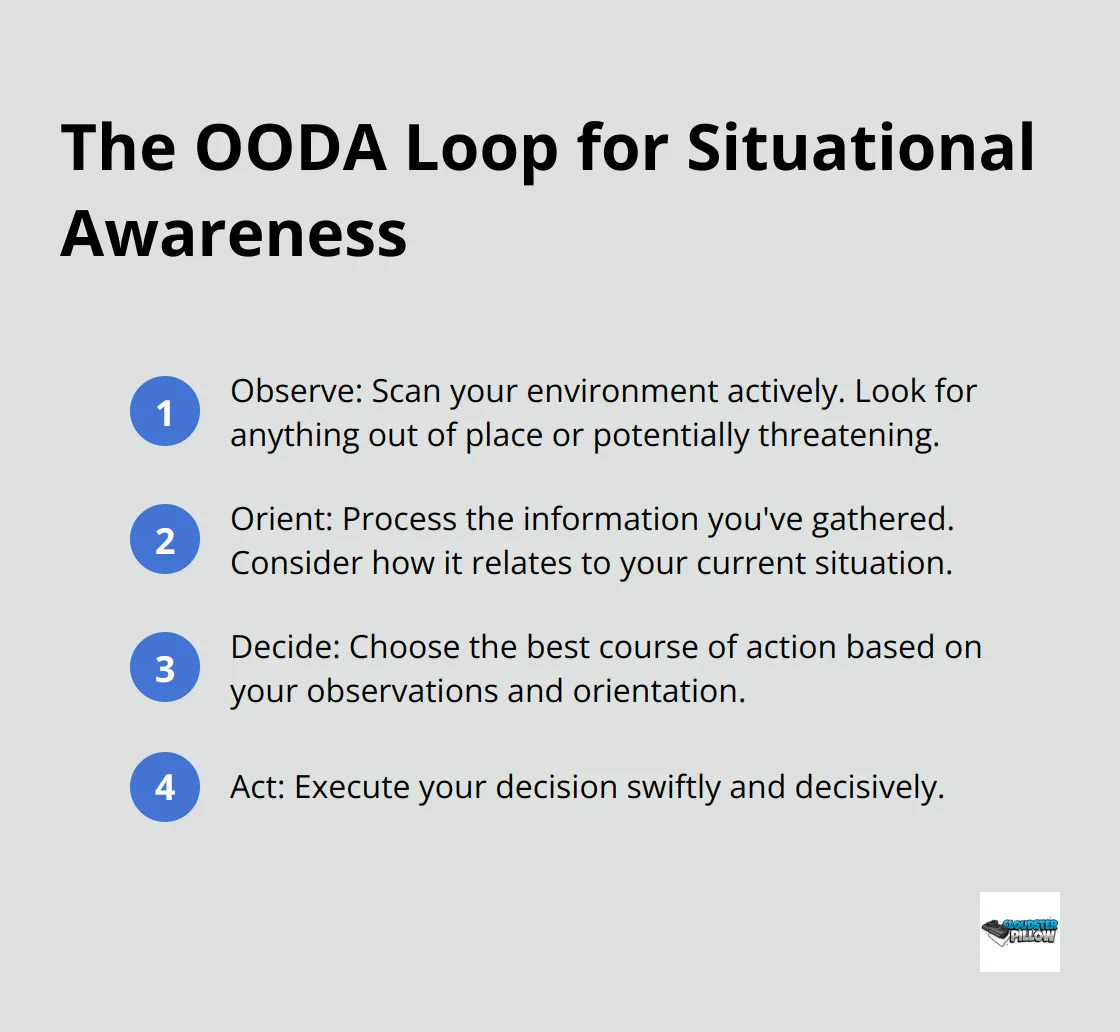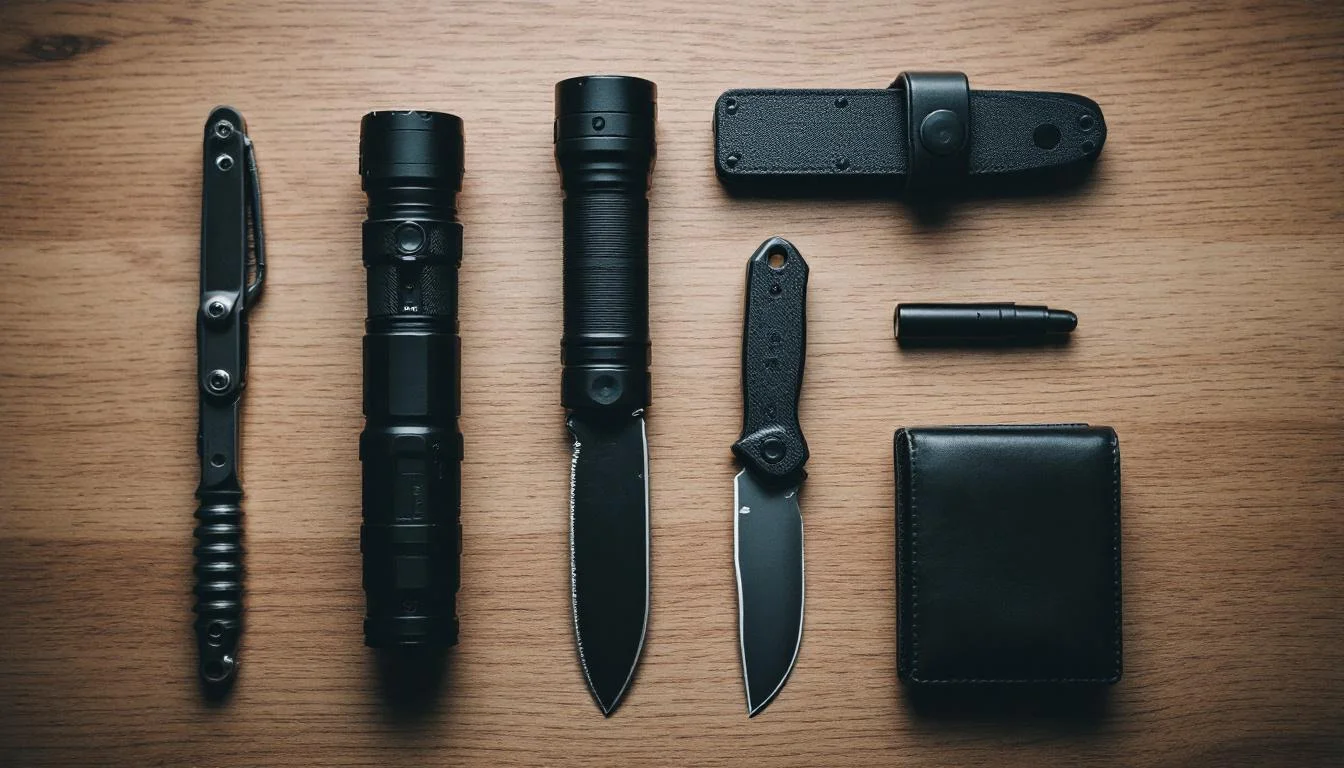CCW Awareness & Mindset, CCW Courses and Tips, CCW Training
Situational Awareness Training for Everyday Carry
At Cloudster Pillow, we understand the importance of situational awareness for concealed carry holders.
Situational awareness training is essential for improving your response in critical situations.
Situational awareness training is a critical skill that can mean the difference between safety and danger in everyday life.
In-depth situational awareness training helps individuals recognize and react to threats more effectively.
This blog post will guide you through understanding, developing, and practicing situational awareness techniques to enhance your CCW preparedness.
Engaging in regular situational awareness training can greatly enhance your confidence in managing unexpected events.
What is Situational Awareness?
Effective situational awareness training prepares you for a variety of environments and potential dangers.
Definition and Importance
Situational awareness is your ability to perceive, understand, and predict events in your environment. For CCW holders, this skill can prevent dangerous situations before they escalate. We at Cloudster Pillow recognize its vital role in enhancing overall safety.
The Three Levels of Situational Awareness
- Perception: You notice relevant details in your surroundings.
- Comprehension: You understand what those details mean.
- Projection: You anticipate how the situation might unfold.
Mastery of all three levels will significantly boost your safety. However, it’s important to note that slowed comprehension and perception can impact situational awareness, as it takes longer to understand verbal, written, or coded information and make sense of things.

Key Components for CCW Holders
Situational awareness training emphasizes the importance of being aware of your surroundings and potential risks.
For concealed carriers, situational awareness involves:
- Scanning: You regularly observe your surroundings, looking for potential threats or unusual behavior.
- Positioning: You always know the locations of exits, cover, and concealment options.
- Body language: You read non-verbal cues from people around you.
- Instinct: You trust your gut feelings (if something feels off, it probably is).
Common Mistakes to Avoid
Many CCW holders make these situational awareness errors:
- Smartphone distraction: Constant phone checks reduce your ability to perceive threats.
- Tunnel vision: You focus too much on one thing and miss other important details.
- Complacency: You let your guard down in familiar environments.
- Normalcy bias: You assume everything is fine when warning signs are present.
Practical Tips for Improvement
Regular situational awareness training is crucial for maintaining a high level of vigilance.
To enhance your situational awareness:
- Practice active observation daily (make it a habit to notice details about people and places).
- Limit distractions (put away your phone when in public).
- Play observation games (try to recall specific details about people you’ve seen).
- Conduct regular environmental assessments (identify potential threats and escape routes).
Situational awareness isn’t about paranoia; it’s about preparation and proactivity. This skill can be honed over time, making you a more prepared and confident CCW holder. As we move forward, let’s explore how to develop these situational awareness skills further.
How to Sharpen Your Situational Awareness Skills
Implementing situational awareness training into your routine can result in life-saving skills.
The OODA Loop in Action
The OODA Loop (Observe–Orient–Decide–Act) serves as a powerful tool for situational awareness. These concepts aren’t complicated. They’re simple tools to help ordinary people spot danger early. Here’s how to apply it in real-life scenarios:

For example, if you notice someone acting suspiciously in a parking lot (Observe), you might recognize this as a potential threat (Orient), decide to change your route (Decide), and walk to a well-lit, populated area (Act).
Situational awareness training also involves understanding how to assess potential threats accurately.
Active Observation Techniques
Improve your observation skills with these practical exercises:
- The Three-Second Rule: Take three seconds to identify potential threats and exits when you enter a new environment.
- The Color Game: Note the colors of objects and people around you mentally. This trains your brain to absorb details quickly.
- The Memory Walk: Try to recall specific details about people, objects, and the layout after leaving a location. This enhances your ability to retain critical information.
The best way to improve your situational awareness is to train regularly and realistically in situations that simulate the challenges and risks you might encounter.
Sharpening Mental Processing
Quick decision-making proves vital in high-stress situations. Try these methods to improve:
- Scenario Planning: Imagine potential threats and plan your responses regularly. This mental rehearsal can speed up your reaction time in real situations.
- Stress Inoculation: Engage in activities that simulate stress (like competitive sports or timed problem-solving exercises). This helps you stay calm under pressure.
- Physical Fitness: Exercise regularly to improve cognitive function and decision-making abilities. It also ensures you’re physically prepared to act if necessary.
Practical Application in Daily Life
Incorporate these techniques into your daily routine to enhance your situational awareness:
- Practice the OODA loop during your commute. Observe your surroundings, orient yourself to potential risks, decide on safe routes, and act accordingly.
- Use active observation techniques while running errands. Try to recall details about people you encounter or the layout of stores you visit.
- Apply mental processing exercises during downtime. Create hypothetical scenarios and think through your responses.
As you continue to hone these skills, you’ll find that situational awareness becomes second nature. This heightened awareness will serve you well in various aspects of your life, not just in your role as a CCW holder. Let’s now explore some practical exercises that will further enhance your situational awareness abilities.
To be effective, situational awareness training must be practiced consistently and realistically.
Practical Drills to Boost Your Situational Awareness
Incorporate situational awareness training drills into your everyday activities.
The Color Code Challenge
Jeff Cooper’s Color Code system provides a powerful tool for threat level assessment. Transform it into a daily drill:

- White: Relax completely for 60 seconds. Notice your vulnerability.
- Yellow: Observe your surroundings actively for 5 minutes. Identify new details.
- Orange: Focus on a person or object as a potential threat for 2 minutes. Note perception changes.
- Red: Visualize a specific threat for 30 seconds. Plan your immediate response.
Rotate through these states throughout your day. This exercise trains your mind to switch between alertness levels quickly and effectively.
The Baseline Behavior Game
Keep refining your skills through ongoing situational awareness training and practical exercises.
Understanding normal behavior helps you spot anomalies. Try this exercise in public spaces:
- Select a location (e.g., a coffee shop or park).
- Observe for 10 minutes. Note typical behaviors, movements, and interactions.
- Identify 3-5 “baseline” behaviors standard for that environment.
- Look for deviations from this baseline (potential indicators of unusual activity).
Practice this exercise in various locations to build a mental library of baseline behaviors. This skill proves invaluable for quickly identifying potential threats in unfamiliar environments.
Real-World Scenario Training
Hands-on experience enhances situational awareness. Try these real-world drills:
Applying situational awareness training in real-world scenarios enhances retention and effectiveness.
- Exit Strategy: Identify all possible exits within 30 seconds when you enter a building.
- The Three-Person Game: Choose three random people in public. Create a brief profile for each based on their appearance and behavior.
- The What-If Drill: Visualize a robbery scenario while in line at a store. Plan your response, considering factors like cover and concealment.
These exercises transform everyday situations into training opportunities, keeping your situational awareness skills sharp and ready.
The Observation Challenge
Enhance your ability to notice and recall details:
- Memory Walk: After leaving a location, list 10 specific details about the environment (e.g., color of the cashier’s shirt, number of windows).
- People Watch: Observe a stranger for 30 seconds, then turn away and describe their appearance and behavior from memory.
- Spot the Difference: In familiar environments, try to identify three things that have changed since your last visit.
These exercises (when practiced regularly) will significantly improve your observational skills and attention to detail.
The Tactical Positioning Game
Continuous situational awareness training ensures that you remain prepared for any situation.
Practice optimal positioning for safety and awareness:
- Corner Clearing: When approaching corners or blind spots, practice proper techniques to clear them safely.
- Back-to-Wall: In public spaces, position yourself with your back to a wall and a clear view of entrances and exits.
- Cover vs. Concealment: Identify potential cover (protection from gunfire) and concealment (visual obstruction) in various environments.
This game enhances your ability to navigate spaces tactically, improving your overall situational awareness and preparedness.
Final Thoughts
Commit to lifelong situational awareness training for ongoing personal safety and security.
Situational awareness training forms the foundation of responsible concealed carry. The OODA loop, active observation techniques, and mental processing exercises equip you with powerful tools to enhance your safety and preparedness. We at Cloudster Pillow believe that comfort and concealment play a vital role in effective everyday carry.
Our adjustable concealment pillow complements your situational awareness skills by ensuring comfortable and discreet carry. This allows you to focus on your surroundings without distraction, improving your overall readiness. Situational awareness requires ongoing refinement and presents new opportunities to sharpen your abilities each day.
Investing in situational awareness training not only benefits you but also those around you.
You will become a more responsible CCW holder and a more aware individual in all aspects of life through consistent practice. Start small by incorporating one or two exercises into your daily routine. As you grow more comfortable, increase the complexity and frequency of your practice. Soon, you will naturally scan environments, identify potential threats, and make quick, informed decisions.


Pingback: How to Improve Your Situational Awareness for Everyday Safety - Cloudster Pillow